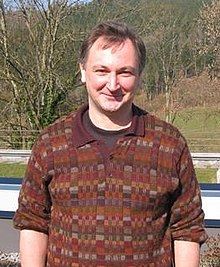Vladimir Voevodsky
Appearance

Vladimir Alexandrovich Voevodsky (4 June 1966 – 30 September 2017) was a Russian-American mathematician. His work in developing a homotopy theory for algebraic varieties and formulating motivic cohomology led to the award of a Fields Medal in 2002. He is also known for the proof of the Milnor conjecture and motivic Bloch–Kato conjectures and for the univalent foundations of mathematics and homotopy type theory.
| This article about a mathematician is a stub. You can help out with Wikiquote by expanding it! |
Quotes
[edit]- A technical argument by a trusted author, which is hard to check and looks similar to arguments known to be correct, is hardly ever checked in detail
- Mathematical research currently relies on a complex system of mutual trust based on reputations. By the time Simpson's paper appeared, both Kapranov and I had strong reputations. Simpson's paper created doubts in our result, which led to it being unused by other researchers, but no one came forward and challenged us on it.
- It soon became clear that the only real long-term solution to the problems that I encountered is to start using computers in the verification of mathematical reasoning.
- Today we face a problem that involves two difficult to satisfy conditions. On the one hand we have to find a way for computer assisted verification of mathematical proofs. This is necessary, first of all, because we have to stop the dissolution of the concept of proof in mathematics. On the other hand, we have to preserve the intimate connection between mathematics and the world of human intuition. This connection is what moves mathematics forward and what we often experience as the beauty of mathematics.
Quotes about Vladimir Voevodsky
[edit]- Voevodsky's construction makes it possible to obtain an “incarnation” of the motivic cohomology but it does not, however, find a solution to the standard conjectures, which are still today – along with the Hodge conjecture – the fundamental open question in modern algebraic geometry.
- Claudio Bartocci; Renato Betti; Angelo Guerraggio; Roberto Lucchetti (1 October 2010). Mathematical Lives: Protagonists of the Twentieth Century From Hilbert to Wiles. Springer Science & Business Media. p. 179. ISBN 978-3-642-13606-1.
- Within mathematics itself, Voevodsky's proposal, if adopted, will create a new paradigm. In his “fairy tale” and some of his other papers, Langlands made deft use of categories and even 2-categories, but number theory is only superficially categorical, and so is the Langlands program. In the event that Univalent Foundations could shed light on a guiding problem in number theory — the Riemann hypothesis or the Birch Swinnerton-Dyer conjecture, which is not so far removed from Voevodsky's motives — then we could easily see Grothendieck's program absorbing the Langlands program within Voevodsky's new paradigm.
- Michael Harris (30 May 2017). Mathematics without Apologies: Portrait of a Problematic Vocation. Princeton University Press. pp. 219–220. ISBN 978-1-4008-8552-7.
- Infinity-groupoids encode all the paths in a space, including paths of paths, and paths of paths of paths. They crop up in other frontiers of mathematical research as ways of encoding similar higher-order relationships, but they are unwieldy objects from the point of view of set theory. Because of this, they were thought to be useless for Voevodsky’s goal of formalizing mathematics. Yet Voevodsky was able to create an interpretation of type theory in the language of infinity-groupoids, an advance that allows mathematicians to reason efficiently about infinity-groupoids without ever having to think of them in terms of sets. This advance ultimately led to the development of univalent foundations.
- Kevin Hartnett (19 May 2015). "Will Computers Redefine the Roots of Math?". Quanta Magazine.

